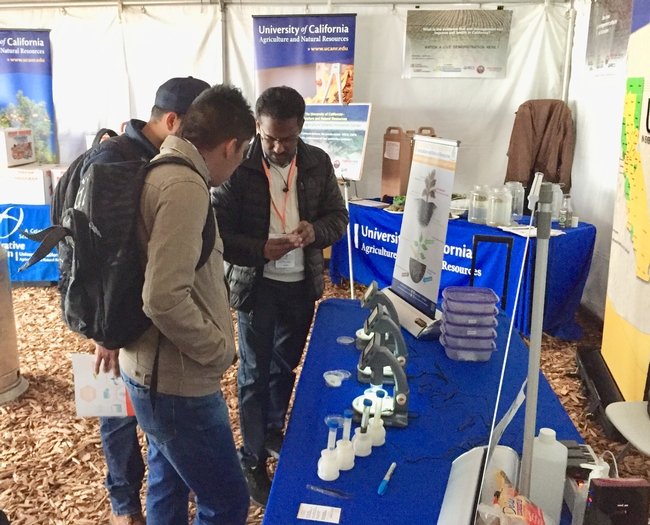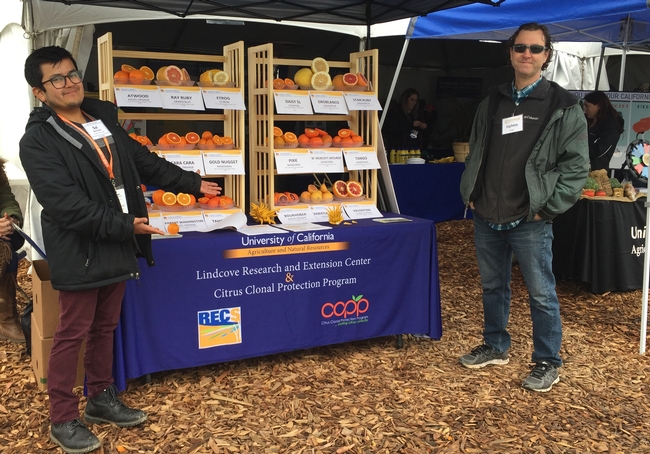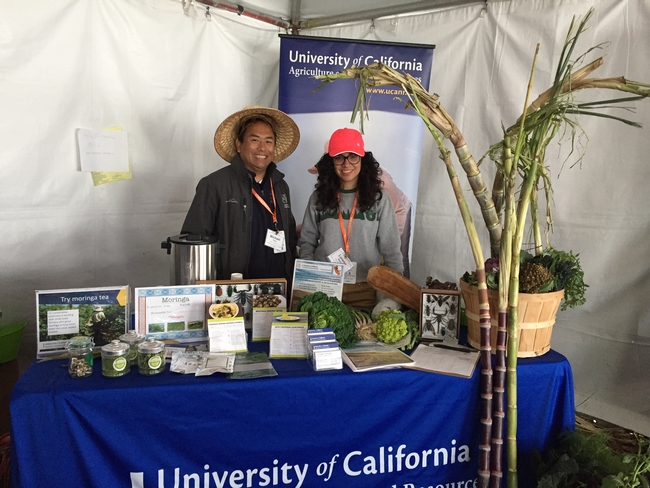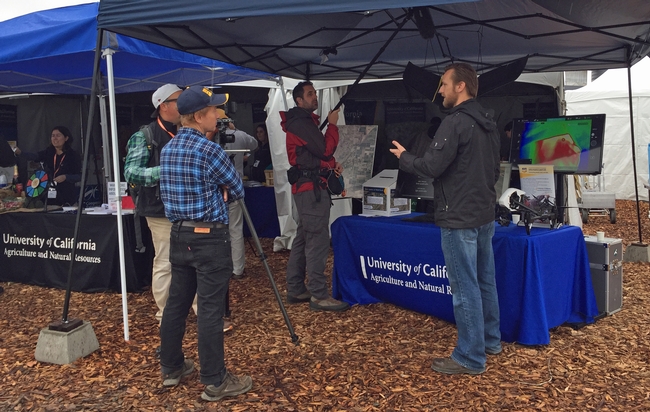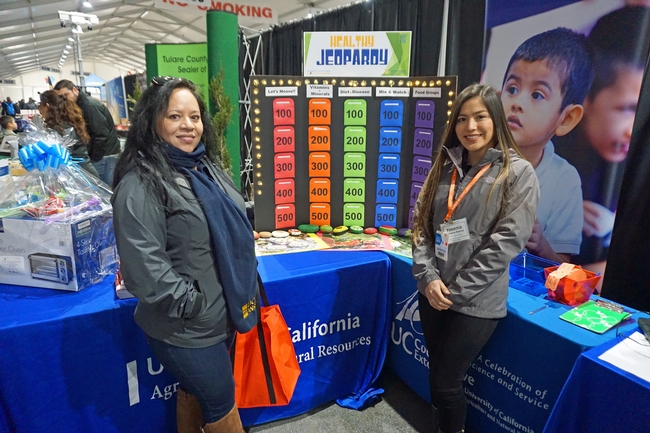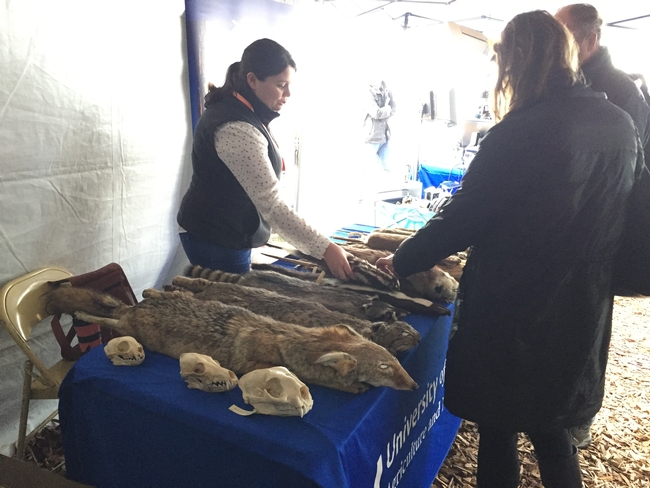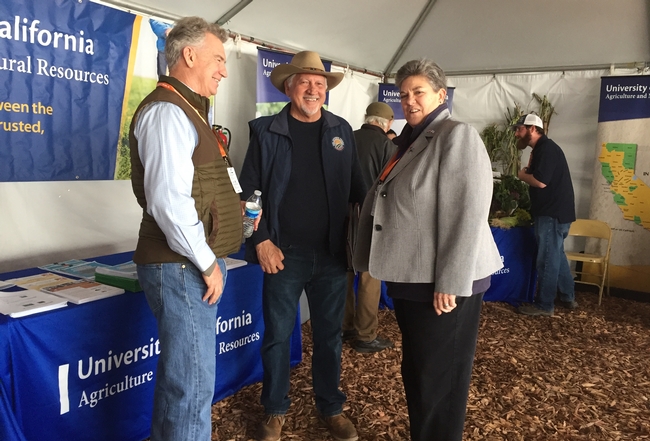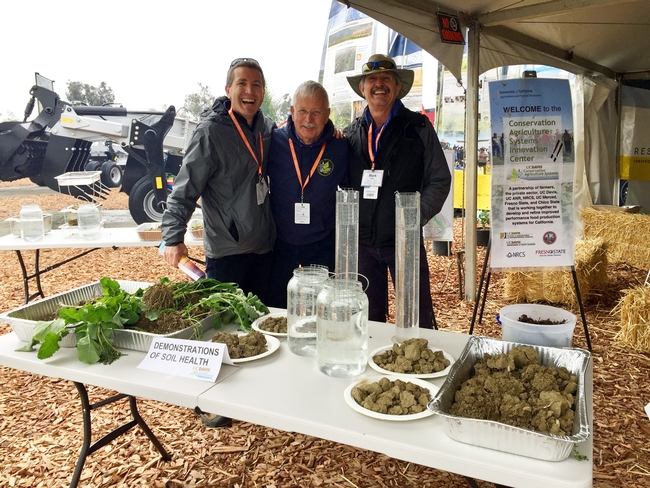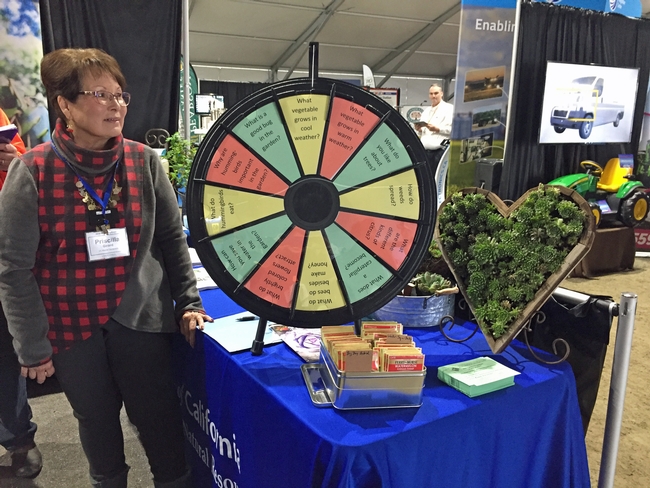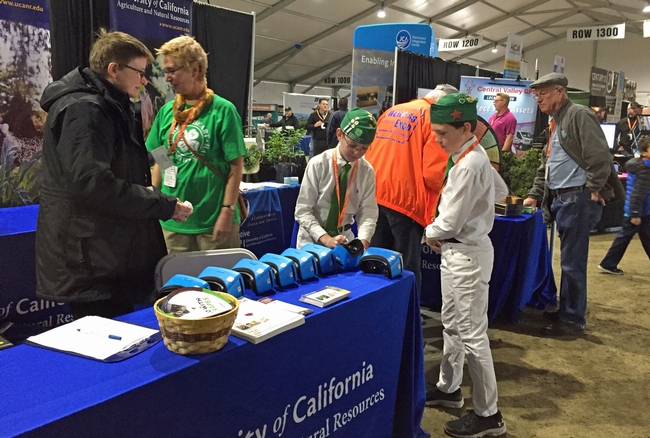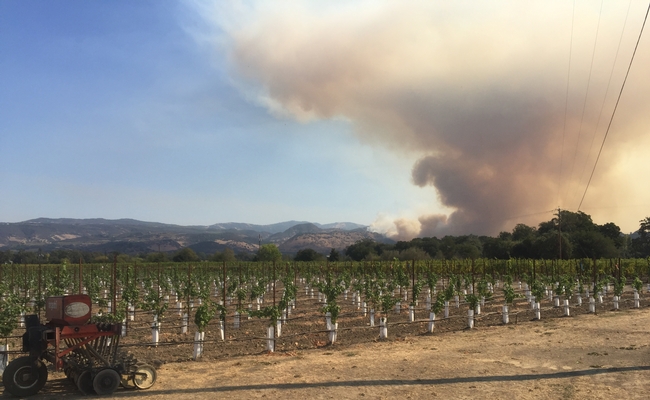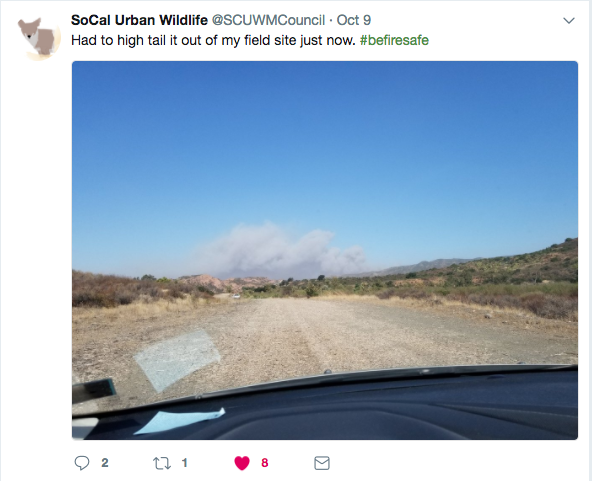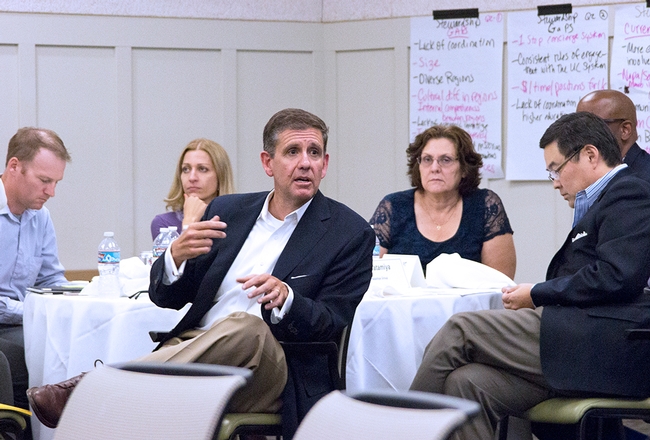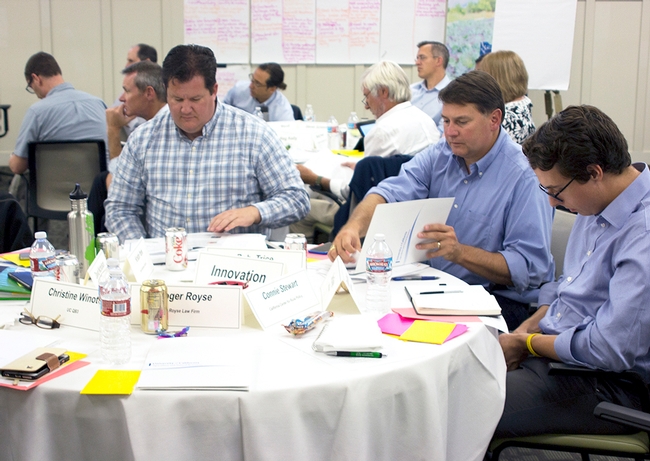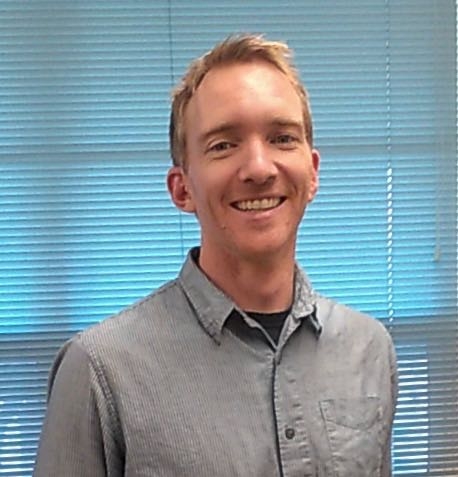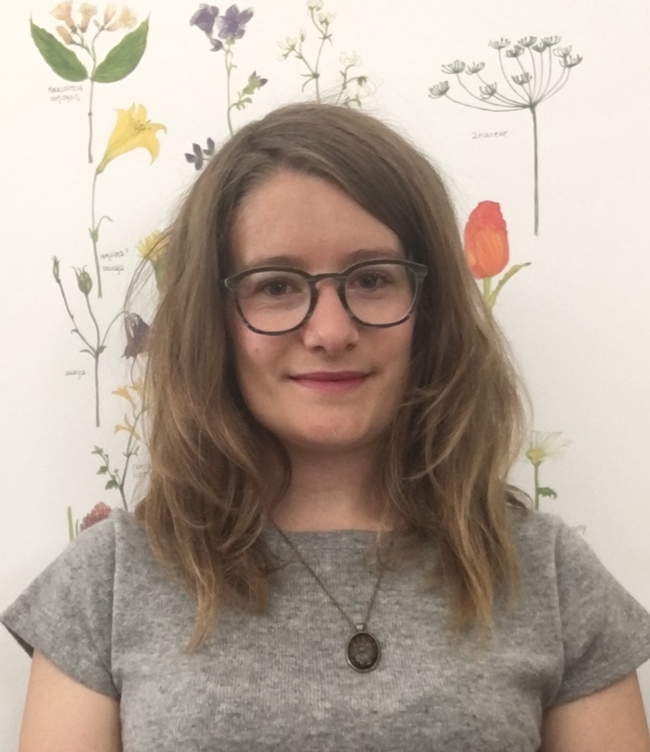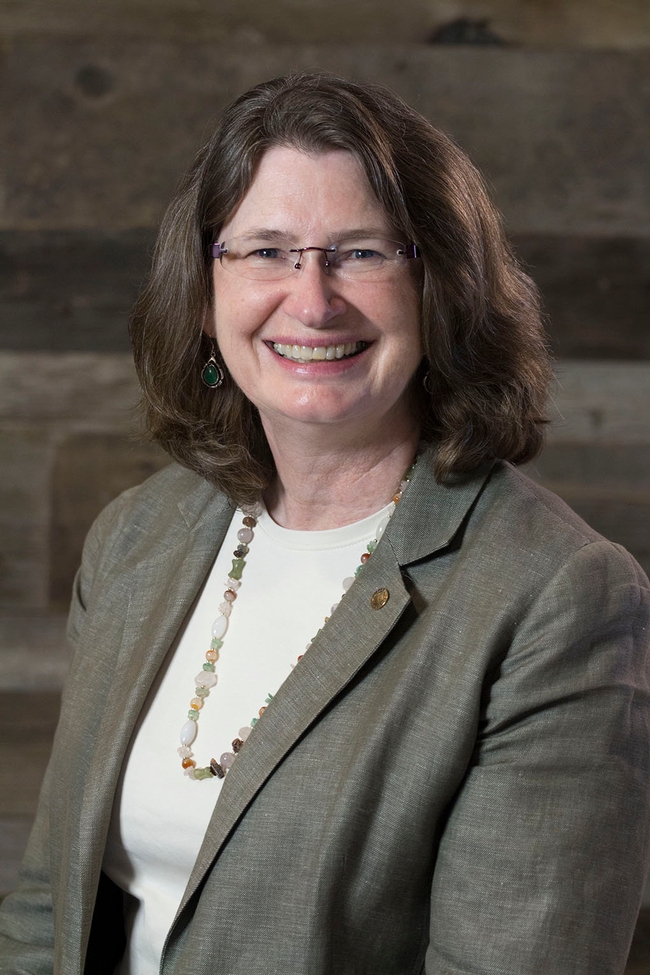Posts Tagged: Niamh Quinn
ANR meets the public at World Ag Expo
People from across California and around the world got to taste new crops, see research demonstrations and learn about several UC ANR activities at the World Ag Expo Feb. 12-14. Despite the cold rainy weather, the world's largest agricultural exposition attracted 102,878 people representing 48 states, the District of Columbia and 65 countries to Tulare.
At an outdoor tent, Beth Grafton-Cardwell, UC Cooperative Extension specialist, Greg Douhan, UCCE citrus advisor, and other researchers, handed visitors fresh Tango citrus grown at the Lindcove Research and Extension Center and told them about their citrus variety research.
Ruth Dahlquist-Willard, UCCE small farms advisor, and Michael Yang, small farms and specialty crops agricultural assistant, encouraged visitors to taste moringa tea. Surendra Dara, UCCE entomology and biologicals advisor, described how Bagrada bugs and other pests under the microscopes can be controlled by microbes. Roger Baldwin, UCCE wildlife specialist, and Niamh Quinn, UCCE urban wildlife conflict advisor, took turns showing taxidermy vertebrate pests and describing their management research.
Jeff Mitchell, UCCE specialist, and Jeff Dahlberg, Kearney Agricultural Research and Extension Center director, gave demonstrations to show the superior health of soils managed with conservation techniques.
Demonstrating the use of high-tech in agriculture, Sean Hogan, Informatics and Geographic Information System academic coordinator, Andy Lyons, IGIS program coordinator, and Jacob Flanagan, IGIS programmer, showed how they use drones and cameras in agricultural research.
Inside Pavilion A, Teresa Rios-Spicer, UCCE nutrition program manager, andYeseniaMedrano, UCCE community education specialist, both from Tulare County, challenged visitors to test their nutrition knowledge by playing Jeopardy! Visitors could spin the UC Master Gardeners prize wheel to answer gardening questions and win seeds. 4-H members invited youth to peer into virtual reality goggles to give them an idea about the fun activities that can be part of joining 4-H.
Frank Mitloehner, UC Cooperative Extension specialist, gave a seminar explaining confusion in the media about the amount of greenhouse gas livestock emit in California and globally. He reviewed the innovations in livestock production that are leading the way to a "greener future" for California and U.S. agriculture.
Beth Grafton-Cardwell, UC Cooperative Extension citrus entomology specialist, and Victoria Hornbaker of the California Department of Food and Agriculture, gave an update on regulatory protocols relating to Asian citrus psyllid and HLB quarantines and the proper transportation of bulk citrus to prevent the spread of the pest and disease.
The California and Dutch AgFoodTech innovation partners reunited in Tulare for a networking luncheon to share their action plan with invited guests and scope the projects.
UCCE spared by October wildfires
California will be dealing with the effects of the October 2017 wildfires for years to come. The Northern California wildfires that ignited Oct. 8 grew into urban conflagrations and burned for days, killing 43 people and destroying at least 8,400 structures.
In Southern California, Niamh Quinn, UC Cooperative Extension human-wildlife advisor, tweeted a photo after outrunning the Canyon Fire 2, which burned over 9,000 acres and destroyed 25 structures.
Brian Oatman, director of Risk & Safety Services, contacted UC Cooperative Extension employees in Sonoma, Napa, Marin, Mendocino, Lake, Butte, Sutter, Yuba and Orange counties and at the Hopland, Sierra Foothill and South Coast research and extension centers.
On Oct. 10, Oatman sent an email to the ANR community giving a status report on the UC ANR offices in the fire zones, saying, “We have heard that all employees are safe.” He added, “In many counties, staff know of 4-H or Master Gardener families who have lost homes or suffered damage.”
In Solano County, 17 UC Master Gardener volunteers, maybe more, lost their homes in the fires. The UC Master Gardener Program quickly set up an online form to connect Master Gardener volunteers throughout the state who wanted to offer lodging, supplies and words of support to fellow volunteers impacted by the fires.
In Sonoma County, UC Cooperative Extension staff and 4-H members helped rescue livestock.
ANR suffered no significant property damage, but some offices closed due to local evacuation orders.
Kaan Kurtural, UC Cooperative Extension viticulture specialist based in Oakville, said the viticulture research station went without electricity for 16 days. They brought in generators from UC Davis.
To help evacuated Californians who returned to their homes recover from fires, Strategic Communications created a story map with links to UCCE county resources.
News reporters sought out several UC ANR experts to explain why the wildfires spread so quickly and burned so intensely and how the fires would affect agriculture. See the ANR News blog for the monthly news roundup for October.
If you would like volunteer or donate to fire recovery efforts, check with local food banks or organizations such as Sonoma County Recovers to find out what is needed. If you would like to contribute to UC Master Gardener volunteers who are in need, you can fill out a survey that was created to connect resources with the affected volunteers: ucanr.edu/mgrelief.
ANR develops innovation incubation strategy
“If UC ANR isn't an incubator, I don't know what is. Furthermore, I would argue that the partnership of our land-grant university system with Cooperative Extension is the original and most productive incubator that the world has ever seen,” VP Glenda Humiston wrote in the October-December 2015 issue of California Agriculture.
Since joining ANR, Humiston has been working to expand UC ANR's incubation activities by joining with diverse partners to develop a much broader innovation infrastructure specifically designed to support intellectual property, innovation, entrepreneurship, tech transfer, startups and commercialization aimed at agriculture, natural resources and rural communities.
“A lot of people have ideas, but they don't know how to be business leaders. An incubator connects them with the things they need to be successful as new entrepreneurs,” said Gabe Youtsey, chief information officer.
To kick off development of such a system, Humiston brought together 40 people on Aug. 30 with a wide range of expertise and representing a variety of sectors: agriculture, banking, business, government, technology and higher education – including leaders of several successful incubators. The purpose of the meeting, held at the ANR building in Davis, was to engage the group in developing a comprehensive strategy to nurture new technologies and innovative businesses for agriculture and natural resources.
“We're not looking to reinvent the wheel or duplicate existing efforts,” Humiston said, explaining that she hopes to support and leverage the strengths and efforts of partners.
Christine Gulbranson, UC senior vice president of research innovation and entrepreneurship, and Reg Kelly of UC San Francisco, who created QB3, – one of UC's best performing incubators – participated in the session. The quantitative biologists at UC Berkeley, UC San Francisco and UC Santa Cruz who comprise QB3 take on challenges in biology using physics, chemistry, and computer science. QB3's Startup in a Box provides legal and grant-writing help for biotech startups.
“We want to take the QB3 model and modify it for ANR,” Humiston said. “But we don't have the resources to build a statewide system by ourselves so we're catalyzing like-minded partners to jointly develop the needed statewide innovation infrastructure.”
Such an innovation system could benefit a wide array of entrepreneurs in rural areas and help to commercialize ideas generated by UC Cooperative Extension specialists and advisors.
“Over the past eight years, ANR researchers have filed 148 patents,” Humiston said. “However, it is unclear if many of those had the support they needed to go the next step.”
At the meeting, the group divided into five tables of eight people. Each table had representatives of UC ANR, various UC campuses, state and federal government, funding institutions, incubators, and different industries. They discussed issues around innovation, place, talent, stewardship and engagement, answering the following questions:
- What exists now?
- Where are the gaps that need to be filled?
- Which of these gaps could UC ANR help catalyze and fill, either with partners or on its own?
- How could this work to fill the gaps be funded?
- How do we measure success?
Conversations were lively and many ideas were brought forth for specific projects and other implementation. “It's really exciting,” said Humiston. “People were jazzed. Virtually all of the participants said they want to work with us on next steps.”
In addition to Humiston and Youtsey, AVP Wendy Powers and UCCE advisors David Doll and Andre Biscaro participated for ANR. Consultant Meg Arnold is writing up a report, which is expected to be released in early October.
Names in the News
Mathesius named UCCE agronomy advisor in Capitol Corridor
Konrad Mathesius (pronounced “Muh-tay-zee-us”) is the new UCCE agronomy advisor for Yolo, Sacramento and Solano counties.
Mathesius, who joined ANR on June 27, will be working with growers and pest control advisers in the Capitol Corridor area to address issues related to soils, pests, diseases and production efficiency. In addition to collaborating on a few projects with UCCE advisor Rachael Long in alfalfa, dry beans and sunflowers, he will work on a wide range of agronomic crops including corn, wheat, barley and safflower.
Mathesius will work with growers and PCAs to mitigate crop losses by addressing pest and disease pressures and to help them comply with nitrogen, pesticide and water regulations. He also plans to develop crop guidelines based on difficulties associated with specific soils in the Capitol Corridor.
The native of Logan, Utah, earned his undergraduate degree at Utah State and his master's degrees in soil science and international agricultural development at UC Davis.
“After graduation, I spent a few years working in the private sector, where I gained a sense of respect for bottom lines and the hustle to make ends meet,” Mathesius said. “I intend to bring the question of cost and efficiency into most, if not all of my work.”
Based in Woodland, Mathesius can be reached at kpmathesius@ucanr.edu and (530) 666-8704.
Stein joins ANR as AVP executive assistant
Kathryn Stein has joined ANR as executive assistant to Wendy Powers, Associate Vice President
Prior to joining ANR, Stein worked in the College of Engineering Dean's office at UC Berkeley for three and a half years. She earned a B.S. in environmental horticulture and urban forestry from the College of Agricultural and Environmental Sciences at UC Davis. While in Davis, she worked for the Whole Earth Festival, an annual sustainability festival on the UC Davis campus.
Stein is based on the 10th floor of UCOP and can be reached at Kathryn.Stein@ucop.edu and (510) 587-6240.
Martinez and Au receive NIH Career Development Awards
Two researchers at the Nutrition Policy Institute have been awarded K01 Career Development Awards by the National Institutes of Health (NIH) National Heart, Lung, and Blood Institute. Lauren Au will research disparities in the relationship between the school nutrition environment and childhood obesity and Suzanna Martinez will study sleep duration and risk for obesity in Mexican-American children.
Martinez will receive $895,620 and Au will receive $840,871. Martinez has also been accepted into the K Scholars Program at UC San Francisco, which will provide her with peer support and mentorship to conduct the study.
Allen-Diaz honored by APLU
Barbara Allen-Diaz, who retired as ANR vice president in 2015, is among five Land Grant university leaders recognized for Excellence in National Leadership by the Experiment Station Section of the Association of Public and Land-grant Universities (APLU).
The other individuals honored with Allen-Diaz were:
- Walter A. Hill, Dean, College of Agriculture, Environment and Nutrition Sciences, Tuskegee University
- Steve Slack, formerly associate vice president for agricultural administration and director of OARDC, The Ohio State University (recently retired)
- Daniel Rossi, formerly executive director, Northeastern Regional Association of State Agricultural Experiment Station Directors (recently retired)
- William (Bill) Brown, dean of research and director of the Tennessee Agricultural Experiment Station, University of Tennessee
The resolution reads in part: “These leaders have personified the highest level of excellence by enhancing the cause and performance of the Regional Associations and Experiment Station Section in achieving their mission and the Land-grant ideal.”
The awards were announced at the annual Experiment Station Section meeting on Sept. 21 in Jackson Hole, Wyo.
UC ANR introduces Zoom for online conferencing
UC ANR is ready to roll out Zoom conferencing to all UC ANR staff and academics, announced Gabe Youtsey, chief information officer.
“Zoom is the easiest to use high-quality video, phone and web conferencing service on the market,” said Youtsey. “After an extensive analysis, the UC has established a systemwide Zoom contract for a very low cost, which UC ANR IT is covering. Our goal is for Zoom to become the common tool for communication within the division, and for collaboration with campus and external teams worldwide.”
Zoom can replace Skype, Adobe Connect, GoToMeeting and ReadyTalk. Some of Zoom's features include:
- Super easy video conferencing on your computer, mobile device, or room system for up to 50 connections
- Unlimited phone conferencing for up to 50
- Ability to support large meetings with up to 100 and webinars up to 500 participants (see instructions below)
- Enabled for PC, Mac, Android and iOS devices
- Compatible with any existing teleconference phones from Polycom, Tandberg, LifeSize etc.
Everything you need to log in and get started using Zoom is at http://ucanr.edu/sites/zoom. If you have a UC ANR portal account and @ucanr.edu email address, log in at https://ucanr.zoom.us.
Additional Zoom features are available to ANR employees:
- ANR has a license for a 100-participant meeting (two-way communication), which can be reserved for occasional use at no cost.
- ANR has a license for 500-participant webinars (one-way communication, which can be reserved for occasional use at no cost.
- There are a range of large meeting and webinar licenses you can purchase as “add-ons” for your exclusive use if needed. Contact the IT Service Desk for more information.
- Zoom Rooms is a great way to connect conference rooms to the Zoom service for high-quality video, phone and web conferencing. Contact the IT Service Desk for more information for equipment and pricing information.
For help to get Zoom up and running, contact the ANR IT Service Desk at help@ucanr.edu or call (530) 750-1212.

